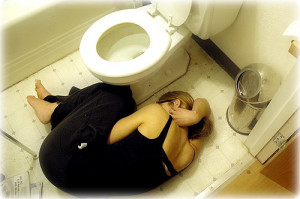There’s no way one single person can possibly review every single piece of peer reviewed literature related to wine that is published every day. This series presents multiple new papers (within the past year or two) in one post by briefly summarizing the research and linking to the source in order for you to pursue further if you’re interested. If there is enough reader interest, I can review any of the papers introduced to you in this post in a more critical assessment.
VITICULTURE/ENOLOGY
“Changes in sour rotten grape berry microbiota during ripening and wine fermentation”. This article, published in 2012, aimed to determine the community structures of yeasts, lactic acid bacteria, and acetic acid bacteria in healthy grapes and grapes afflicted with sour rot, and how the winemaking process does or does not change these populations. Using healthy and sour
![NOBEL ROT (Not sour rot): Photo by davitydave (Flickr: IMG_0556.JPG) [CC-BY-2.0 (http://creativecommons.org/licenses/by/2.0)], via Wikimedia Commons](http://www.academicwino.com/wp-content/uploads/2013/04/Noble-Rot-The-Academic-Wino-223x300.jpg)
NOBEL ROT (Not sour rot): Photo by davitydave (Flickr: IMG_0556.JPG) [CC-BY-2.0 (http://creativecommons.org/licenses/by/2.0)], via Wikimedia Commons
Results showed that sour rotten grapes showed significant increases in their populations and species diversity of yeasts and acetic acid bacteria counts, while lactic acid bacteria populations were low for both sour rotten grapes and healthy grapes. The bacterial species Acetobacter orleaniensis and Acetobacter syzygii were present only in sour rotten grapes. The yeast species Dekkera bruxellensis and Oenococcus oeni were found only after primary fermentation in all wines, and after malolactic fermentation, racking, and SO2 addition, the only yeast species found were Trigonopsis cantarellii and Saccharomyces cerevisiae (in all wines). The concluding results were that there are significant microbiotic changes in grapes that are afflicted with sour rot, with potential implications for early detection in the field for treatment or sorting purposes prior to winemaking.
CONSUMER PREFERENCES
“What matters to consumers of organic wine?”. This article, published in 2012, aimed to determine how important the distinction of “organic” of a wine is to consumers, and what other attributes of the wine are important to those that consume organic wine. To examine this issue, surveys were sent out to around 400 Swiss wine drinkers, which asked questions related to the judgment of different wine labels, how the image and make-up of an organic wine label influences their purchase behavior, and questions related to demographics of each survey participant.
The results showed that the most important attribute for these Swiss wine drinkers was price and country of origin (they preferred French over Swiss wine). The “organic” attribute was less important than price and country of origin; however, it was more important than the color of the wine. Those participants that considered themselves healthy, as well as urban residents and female consumers were more likely to consume organic wine than their other fellow participants. From these results, the authors suggest the Swiss wine market should focus their advertising on the healthy image of wine, as well as direct the marketing toward urban women in order to maximize likelihood of purchase for organic (and other) wines.
HEALTH
“The antimicrobial effect of wine on Bacillus cereus in simulated gastro-intestinal conditions”. This article, published in 2012, aimed to determine if wine could protect against Bacillus cereus infection (i.e. results in food poisoning) in the human digestive system, using a simulated experimental design. Survival of Bacillus cereus when exposed to wine was first testing in inoculated TSB media (i.e. not simulated human conditions). Next, survival of B. cereus when exposed to wine was tested in simulated human digestive system conditions, by creating an environment very similar in chemistry to the inside of the human digestive system.
Results from the first test showed that B. cereus spores were resistant to wine exposure, however, B. cereus cells in the vegetative state were highly sensitive to wine and were significantly reduced when exposed to wine. The authors broke down the components of the wine to determine which components were responsible for this decrease in vegetative B. cereus cells, and found that wine
organic acids reduced B. cereus vegetative cells, which wine phenolic compounds had no effect on B. cereus vegetative cells. Similar results were found in the human digestive system simulation experiment, with wine (total wine, not just wine parts) significantly reducing B. cereus vegetative cells and somewhat reducing B. cereus spores. The authors concluded that wine therefore may have a protective/antimicrobial effect against the food poisoning causing B. cereus, and that it is the organic acids in the wine (and not the polyphenols) that seem to be providing that protection.

